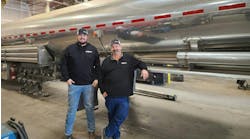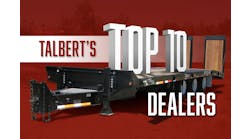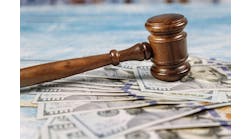Leadership transition at Aurora Parts is next step in move from hardware distributor to high-tech solutions provider
A search of the online archives of Trailer/Body BUILDERS for items featuring Aurora Parts & Accessories returns a pretty good look at trends in the aftermarket parts business for the past 20 years. So, with the Jan. 1, 2020 move by long-time President and CEO Dave Clarke to the role of board chairman, and with the promotion of current VP and COO Brad Fulkerson to Clarke’s position, TBB took the opportunity to sit down with the leadership team of the semi-trailer parts distribution giant to get their take on how the business has changed in the last decade or two, and where the industry is headed.
The interview was structured around an October 2009 TBB article in which Clarke discussed the results of a comprehensive fleet survey undertaken by Aurora. At the time, Clarke suggested that trailer aftermarket support networks lagged other heavy-duty dealer groups, most notably tractor dealers and distributors. The gap was particularly evident in the areas of technology. What has changed? Has that gap been narrowed?
“There’s been a fairly dramatic shift in the way that fleets have approached the service model. Ten years ago, probably 70+% of a fleet’s trailer aftermarket parts and service maintenance was done in their facilities,” said Clarke, who has more than 30 years’ experience in the heavy-duty aftermarket industry. “During that same period, we started getting these new factors that hit the industry like CSA [the Compliance Safety Accountability program], and there was a lot of pressure on capital after the 2008 downturn as far as getting higher utilization out of the trailing asset.
“Back in the day, if you were getting 80% or greater utilization in your fleet, you were probably okay. With the tightening on capital, today if you’re not in the mid-90% range on utilization, you’re probably in trouble. CSA was looming, and along comes electronic logging devices further accelerating pressure on the use of the trailing assets. So what came from all of this was [trailer] maintenance moved from the fleet shop to a more mobile services platform across the industry.”
And for Aurora, as he explains, that meant the old model—selling parts to dealers and fleets for their repair shops—needed to adjust. Fleets demand service for these highly utilized “nomadic assets” wherever they happen to be between jobs because, essentially, they rarely returned home.
“The industry was not prepared for—and is still working to really embrace and improve—this larger services network with all these thousands of mobile people now doing work on fleet equipment,” Clarke said. “We used to be a fairly closed-loop, controlled system. It’s a very open environment today.
“This whole new network has created a lot more friction for the fleet. With the utilization rates of the past, fleets had a lot more trailers parked that they could use in the case of having to provide maintenance or wait for parts. Those days are gone. So even the time to move a trailer from a site to a dealership is now a premium. As a result, they’re really looking for that on-site repair, wherever that trailer is sitting.”
The upshot: The “great” technology and tools Aurora had developed for the traditional B2B aftermarket channel have had to be reimagined.
“Now we have to take that technology—the speed, the accuracy—to a different type of platform, which is generally a smartphone, a tablet, etc., because that’s what those mobile people are using to access information. And we’re having to transact very differently than we have in the past,” Clarke said.
Similarly, Clarke suggests that the complexity of modern tractors and powertrains, coupled with the shortage of technicians, means fleet shops must dedicate their resources to power unit maintenance, “compounding” on the trailer side the outsourcing of the aftermarket parts and service to independent repair and service providers.
And, as Fulkerson is quick to point out, the FleetPerform platform that Aurora developed after the 2009 survey remains a very powerful tool for fleets doing business with the dealer network.
“We still have a number of projects that we continue to develop on that platform today to address those issues as they expand, and to address new issues between the fleets and the dealers as well,” Fulkerson said. “One big reason fleets have opted to grow their presence in FleetPerform is because it’s one of the few platforms that allows them visibility into exactly where the right parts are at the right price.
“FleetPerform has been recently enhanced with a new FleetPerform Service Locator application that will allow fleets to quickly locate service network providers of all types. In the future, we’re planning enhancements that will allow the network to broadcast service availability in real time so that a fleet can more easily find people who have the ability to work on a trailer today and not in a week or in two weeks.”
Indeed, as Clarke adds, Aurora has shifted from primarily focusing on the dealer experience with internal system technology to a focus that includes more targeted retail technology for the end user and fleet experience. Aurora has evolved from focusing on their parts sales to the dealers’ sales, and now more to end-user equipment owner maintenance and repair solutions.
“Aurora has become a technology company that just happens to sell trailer parts,” Clarke said. “Our job isn’t to just sell trailer parts. Instead of meeting expectations, we have to predict future or even latent needs.”
Ultimately, Aurora has had to make sure the tech platforms they create are effective in a continuously advancing industry, Fulkerson explains.
“Today’s end user is looking for a seamless experience in real time. People’s expectations are to have a marketplace that fills all their needs,” Fulkerson said. “They aren’t just looking for a preferred service network but rather a preferred service marketplace. At Aurora, we have the best marketplace with the best dealers. We are responsible for that final mile.”
Report card
Ten years ago, Clarke set a number of priorities for Aurora Parts, and he evaluates the gains made by industry and the company since:
Dealer/distributor network price and service consistency. “I would say the industry is still lacking, overall, the type of national program that provides that consistency—because of fragmentation. There are some semblances of more limited national programs that address parts only,” Clarke said. “I believe that Aurora and its network of dealers are the only ones today really addressing both parts and service in that context.”
Service turn-around commitments. “We’ve spent a lot of time with fleets and call centers over the last 18 months, and we’ve learned that we need, in conjunction with the fleet in our dealer network, to embrace the independent service providers that are just our way of life today,” Clarke said. “The long lead times at the dealership still tends to be where the larger kind of bodywork structural repairs for trailers are performed, but more and more of the routine maintenance is done offsite by the mobile technicians.”
Quality standards for product replacement. “It was a big issue for fleets. But again, it was somewhat of a controlled environment at the time, and we put programs in place to help manage product assurance to make sure they’re getting the quality products they specified, either through the dealer or from us to the dealer,” Clarke said. “But now, when you’re starting to farm out a lot of your aftermarket parts and service work to this independent service provider group, that is not linked up with necessarily any kind of system that is managing product assurance, then fleets have a bigger challenge.
“And that’s one thing we hear over and over: ‘I’m getting my trailer repaired by this independent mobile repair individual, but I’m really, really not sure what’s going back on it.’ So when I talk about bringing the independent service technicians into our enterprise system—our technology platform—we’re working hard to build or reinforce these standards at a fleet-specific level. With our new Aurora Parts to Go application (aurorapartstogo.com), we can communicate fleet-approved parts lists directly to mobile technicians, reinforcing product assurance.”
Comprehensive product offering. Back at the time of that survey, I think we stocked about 12,000 SKUs. Today we’re near 18,000, so we’ve increased by about 50% during that period. It’s that systematic approach to be the all-makes supplier for all manufacturers of trailers,” Clarke said. “I said it back then, and I’d say it today: Fleets want to have that one-stop-shop experience from a product standpoint.
“And again, the same holds true for these mobile people today. With our new e-commerce tools, we don’t want to have them go to multiple dealer locations in an effort to satisfy repair requirements for a fleet. We want to send them to one location, get all the parts they need for all the repairs they’re doing at a fleet’s drop lot, and be on their way.”
Aurora Dealer Advisory Group. “It’s probably been one of the most critical elements of our validation of strategic initiatives, etc. In these advisory group meetings, we share what we’re looking out at three to five years in the future, and then our thoughts around technology and what impact that will have on their businesses,” Clarke said. “When we think we’ve got a better mousetrap, we always try to validate that as best we can with our key members. When we think we’ve done our best to address a particular industry challenge, there’s always a real world that comes up and smacks you. There’s just a lot of common-sense input from the dealers.
“It’s gone so well we’ve increased from the original six to 10 members now to cover North America. We now have a representative from Mexico and one from Canada, and then eight from the US. Small dealers, large dealers, different geographies, dealers that are in servicing tankers, agricultural equipment, both truck and trailer: We get a real blend of business experience.”
Initiatives
The 2009 survey led to a number of key initiatives such as FleetPerform that have since become critical to Aurora Parts’ growth and success over the past decade.
“FleetPerform is absolutely a cornerstone of our company,” Clarke said. “In 2009, we were still largely a parts distributor in many respects. FleetPerform has really transformed us into both a parts and service company. The two really go hand in hand.”
The platform continues to grow at double-digit annual rates, and FleetPerform currently has more than 1.5 million trailers under management. But that growth is now carefully directed.
“The onboarding process is fairly resource intensive. It’s akin to implementing a business system,” Clarke said. “Today, we won’t sign a fleet up for FleetPerform until we’ve done a fairly in-depth audit of service and parts invoices from across the country, to prove to them and ourselves that the overall effort of implementing FleetPerform will deliver the result that they’re looking for.
“Routinely, we can show some of the larger fleets millions of dollars a year in savings. But in some of these large fleets, the decision-making around parts procurement and service choices are still very decentralized. And you have to get the whole organization aligned with the goal.”
And FleetPerform will continue to evolve and the cost savings will grow as connected trailer technology matures, Fulkerson adds.
“Having a smart trailer that knows it needs repair is not helpful unless there’s another system that knows where you can get it fixed—a corresponding system that knows where inventories are; that knows where service capacity is; that knows where dealers are located along a route that driver is on,” Fulkerson said. “Having all of that information in a system such as ours now enables a smart trailer to become a smart maintenance application. That’s obviously not today, but I think that will be there, certainly, in the next five to 10 years.”
The Pro-Fit all-makes product line also continues to grow, with about 3,000 SKUs available.
“We wouldn’t have grown without it,” Clarke said.
Similarly, the Pro-Par line, Aurora’s exclusive brand of OEM quality parts, has been one of Aurora’s “great successes.” Pro-Par has grown to 45 product lines from just 10 in 2009.
Likewise, Aurora’s Graphical Bill of Materials (GBOM) drill-down catalog continues to be a competitive differentiator in the trailer aftermarket, enabling dealers to find the parts they need without being serial-number dependent.
Aftermarket future
The recent boom in commercial vehicle equipment sales, including back-to-back record years for trailer sales, means a much larger trailer population in need of parts and service—but the industry has always been cyclical, rising and falling with the US economy.
Still, the outlook for the industry is “robust,” Fulkerson explains, and Aurora is well-positioned moving forward. To keep up with the fleet demand for speed from parts and service providers, Aurora has opened distribution centers in Atlanta and Dallas over the past four years to complement the 300,000-sq.-ft. headquarters facility in Lebanon, IN.
Fulkerson, who joined Aurora in 2012, was instrumental in the opening of the new distribution centers. Under his leadership, Aurora warehouses streamlined operations, implementing a smart warehouse configuration system, and expanded and improved their delivery service options.
“Where all of our customers potentially ordered one time a week, maybe five years ago, more and more of our regions now have everyday shipping available to them. And we’re able to ship all kinds of products, including 53-foot products, through a lot of those regions,” Fulkerson said. “That’s a real strategic advantage of our supply chain. Everything we build is capable of handling 53-foot goods. A lot of the other heavy-duty networks that aren’t trailer specific just don’t have the infrastructure to move the really large, heavy goods.”
Additionally, the DCs enable Aurora to reduce its transportation spend while also helping dealers grow local market share with daily parts availability. And, he adds, daily parts deliveries mean shops don’t have to maintain as much inventory, freeing precious square footage for repairs rather than storage.
On the drawing board, Aurora has plans for new DCs to serve both the Northeast and West Coast regions, but a timeline for the project hasn’t been set.
In terms of technology, Aurora will continue to move from providing tools to help dealers manage the sales they create, to actually creating sales for their dealers, Fulkerson explains.
“E-commerce, for example. We’ve recently launched a new tool where, if people are searching for trailer parts and they can come across the Aurora Parts to Go website, they’ll be able to search through Aurora trailer parts and they’ll be matched up with local inventory where they can purchase parts from a participating Aurora dealer,” he said. “This is going to be a huge opportunity to grow our dealers’ business.”
And speaking of e-commerce, Fulkerson suggests that being competitive in the age of Amazon is all about “speed, speed, speed” and visibility.
“We’re obviously building out our PDC network in our delivery trucks so that we have better visibility into where our parts are. We can move them around and make them available to dealers and fleets more quickly,” he said. “We’re also working with the dealers to make their inventories more visible.
“Going back maybe 10 years ago, I think that a lot of technology was portal based. So, we have the MyAuroraPlus portal and the FleetPerform portal. Our competitors have parts ordering portals, and all the truck OEMs have their portals. I think that people are getting a little portal fatigue in their workflow.
“The future is integration, picking partners and becoming deeply integrated with them,” Fulkerson continues. “With this in mind, a lot of what we’re working on now is helping the dealer analyze their inventory, making it visible to a wide variety of buyers, and then developing the technology that facilitates that purchase. That’s the way that the industry is going.”
Additionally, Aurora is extending the platform to give dealers the capability to manage a customer’s inventory.
“If a local fleet running their own repair shop wants to keep a certain number of parts in stock, they can scan those parts in and out using one of our handheld scanners, and it will trigger orders back to our dealer’s shop. They can automatically bring those parts over as needed,” Fulkerson said. “We’re taking some of the same technologies that have helped us in our relationships with our dealers, and we’re extending them to help the dealer relationship with their customers and fleets.”
For Aurora, success in the coming age of a seamless, integrated supply chain is a matter of continuing to leverage its advantages.
“Ironically, I think that it comes back to a very non-technical component, which is: What are your operational capabilities to fulfill and execute?” Fulkerson said. “Particularly on trailer components, if you consider the demands of really short fulfillment cycles—particularly for a national account who’s managing inventory at 60 or 70 locations across the US, and needs a network that can integrate and provide that inventory throughout—I think what we’re building at Aurora, nationally, is uniquely positioned to fit those needs.
“And there aren’t a lot of other people who will be able to do it, particularly with trailer parts. Customers at some point are going to look for those differentiators. Because if everybody has the same technology offerings, you’re going to be looking for who can do it the best. And that’s why we’re setting out to be the ones who can do it.”









